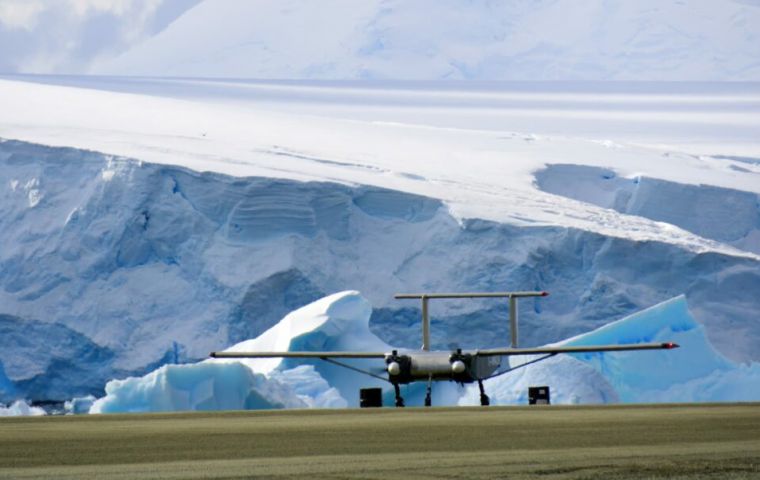MercoPress. South Atlantic News Agency
BAS autonomous drone, Windracers ULTRA, to survey Antarctica at lower cost and lower carbon footprint
 Windracers ULTRA UAV in front of ice cliffs at Rothera Research Station
Windracers ULTRA UAV in front of ice cliffs at Rothera Research Station A team have arrived at Rothera Research Station, ready to start testing the new Windracers ULTRA autonomous drone in Antarctica. If successful, the new drone platform could represent a major addition to British Antarctic Survey’s scientific capability on the frozen continent – offering the potential to do more science at a lower cost, with a lower carbon footprint than traditional crewed aviation.
Designed for extreme environments like Antarctica, the Windracers ULTRA UAV (uncrewed aerial vehicle) is a fully autonomous, twin-engine, 10-metre fixed-winged aircraft, capable of carrying 100 kg of cargo or sensors up to 1000 km. Incorporating a high level of redundancy, the ULTRA can continue to fly even if one of the engines or components is damaged or fails, and has been designed to be fixed in the field with a minimal number of parts.
It can take off, fly and land safely with minimal ground operator oversight thanks to its sophisticated autopilot system Masterless developed and patented by Distributed Avionics. Offering a lower-carbon impact than traditional crewed aviation, the ULTRA UAV stands to play a key role in BAS’ plans to reach net zero by 2040.
If implemented, the drones will be used as a primary tool for airborne scientific surveys, making the most of the flexible configuration available in the platform for a range of scientific instruments. As it stands, British Antarctic Survey undertakes much of its survey work with Twin Otter aircraft. While the Twin Otters operate under an intense logistics and science regime during the field season, the drones could enable dramatic increases in flight time and geographic coverage while yielding a reduction in CO2 emissions per flight hour of around 90%.
The lower cost and greater safety of flying UAV drones over long periods also makes it possible to collect new and higher-fidelity science data. Furthermore, multiple autonomous drones could be deployed as a single unified system using AI-driven SWARM technology.
Dr Tom Jordan, a geophysicist from British Antarctic Survey who specialises in airborne data collection, said: “Demonstrating that UAVs can robustly and routinely collect an array of different data is really exciting for the future of Antarctic science. Polar science urgently needs extensive new high-resolution datasets to understand the ways the Antarctic ice sheet is changing, and how this will impact communities around the world. This is our first step toward unlocking those logistical barriers.”
Airborne surveys are used for a range of science disciplines relevant to polar climate science and ecology, including geology atmospheric, glaciology and the study of ocean ecosystems. Under this season’s testing phase, the Windracers ULTRA will be deployed to:
• survey protected environmentally sensitive areas and assess the marine food chain (krill) using cameras
• investigate tectonic structures with magnetic and gravity sensors
• assess glaciological structures using airborne radar
• test an atmospheric turbulence probe for studies of boundary layer processes coupling ocean and atmosphere
Tom Reed, Autopilot Technology Lead at Windracers Group and a member of the test team in Antarctica, said: “Having spent the last eight weeks completing rigorous tests and training, we’re enormously excited to have made it to Antarctica. We very much hope to demonstrate that high endurance, high payload autonomous drones have a valuable role to play in the future of environmental research. As a software engineer, I would not have predicted that my career would lead me to Rothera Research Station in Antarctica. It’s a genuine privilege and I feel humbled to have the opportunity to spend the next few weeks here working alongside an incredible team on some truly meaningful science projects.
The ground-breaking project is being funded by Innovate UK’s Future Flight 3 Challenge and is part of its pilot program called ‘Protecting environments with uncrewed aerial vehicle swarms’, aimed at demonstrating how advanced drone technology can be used to gather environmental data in Antarctica.




Top Comments
Disclaimer & comment rules-

Read all commentsGods speed
Feb 10th, 2024 - 11:24 am 0Commenting for this story is now closed.
If you have a Facebook account, become a fan and comment on our Facebook Page!